Air-to-Ground Path Loss Model at 3.6 GHz under Agricultural Scenarios Based on Measurements and Artificial Neural Networks
Abstract
:1. Introduction
- A novel ML-based PL model with double-weight-neurons for UAV-aided A2G communications under agricultural scenarios is firstly proposed in this paper. The proposed model takes into account the main factors affecting PL, including signal propagation distance, UAV height, and carrier frequency, and can accurately predict the PL of the line-of-sight (LoS) and non-LoS (NLoS) paths in the scenarios.
- A new ANN structure named double-weight neurons-based ANN (DWN-ANN) is designed for the PL model, which can solve the problem of large measurement data requirements in traditional ANNs and achieve accurate PL prediction through two-step training. Moreover, an RT pre-correction module is introduced to solve the problem of insufficient RT simulation accuracy caused by complex ground materials in agricultural scenarios.
- Channel measurement campaigns are carried out over a farmland area with different ground materials at 3.6 GHz. The measurement data are obtained for the training and validation of the proposed model. Moreover, the ground material parameters for RT simulations are modified. The prediction results demonstrate a fine concordance with the obtained data and achieve higher accuracy compared to the empirical models, which indicates that the proposed model can accurately predict the PL under agricultural scenarios.
2. Proposed ANN-Based PL Model
3. PL Prediction and DWN-ANN Design
3.1. Overview of PL Prediction Scheme
3.2. Network Structure
3.3. RT Data Pre-Correction
4. Validation and Comparison
4.1. Channel Measurement Campaigns
4.2. Data Pre-Processing
4.3. Prediction Results Analysis
5. Conclusions
Author Contributions
Funding
Data Availability Statement
Conflicts of Interest
References
- Shakhatreh, H.; Sawalmeh, A.H.; Al-Fuqaha, A.; Dou, Z.; Almaita, E.; Khalil, I.; Othman, N.S.; Khreishah, A.; Guizani, M. Unmanned aerial vehicles (UAVs): A survey on civil applications and key research challenges. IEEE Access 2019, 7, 48572–48634. [Google Scholar] [CrossRef]
- Galán-Jiménez, J.; Vegas, A.G.; Berrocal, J. Energy-efficient deployment of IoT applications in remote rural areas using UAV networks. In Proceedings of the WMNC’22, Sousse, Tunisia, 17–19 October 2022; pp. 70–74. [Google Scholar] [CrossRef]
- Shi, M.; Yang, K.; Niyato, D.; Yuan, H.; Zhou, H.; Xu, Z. The meta distribution of SINR in UAV-assisted cellular networks. IEEE Trans. Commun. 2023, 71, 1193–1206. [Google Scholar] [CrossRef]
- Hayat, S.; Yanmaz, E.; Muzaffar, R. Survey on unmanned aerial vehicle networks for civil applications: A communications viewpoint. IEEE Commun. Surv. Tutor. 2016, 18, 2624–2661. [Google Scholar] [CrossRef]
- Hua, B.; Ni, H.; Zhu, Q.; Wang, C.-X.; Zhou, T.; Mao, K.; Bao, J.; Zhang, X. Channel modeling for UAV-to-ground communications with posture variation and fuselage scattering effect. IEEE Trans. Commun. 2023, 71, 3103–3116. [Google Scholar] [CrossRef]
- Mao, K.; Zhu, Q.; Song, M.; Li, H.; Ning, B.; Pedersen, G.F.; Fan, W. Machine-learning-based 3-D channel modeling for U2V mmWave communications. IEEE Internet Things J. 2022, 9, 17592–17607. [Google Scholar] [CrossRef]
- da Silva, H.T.P.; de Alencar, M.S.; Assis, K.D.R. Path loss and delay spread characterization in a 26 GHz mmWave channel using the ray tracing method. In Proceedings of the IMOC’19, Aveiro, Portugal, 10–14 November 2019; pp. 1–3. [Google Scholar] [CrossRef]
- Ravuri, V.; Subbarao, M.V.; Terlapu, S.K.; Ram, G.C. Path loss modeling and channel characterization at 28 GHz 5G micro-cell outdoor environment using 3D ray-tracing. In Proceedings of the ICAECT’22, Bhilai, India, 21–22 April 2022; pp. 1–7. [Google Scholar] [CrossRef]
- Mani, F.; Vitucci, E.M.; Barbiroli, M.; Fuschini, F.; degli Esposti, V.; Gan, M.; Li, C.; Zhao, J.; Zhong, Z. 26GHz ray-tracing pathloss prediction in outdoor scenario in presence of vegetation. In Proceedings of the EuCAP’18, London, UK, 9–13 April 2018; pp. 1–5. [Google Scholar] [CrossRef]
- Leonor, N.R.; Sánchez, M.G.; Fernandes, T.R.; Caldeirinha, R.F.S. A 2D ray-tracing based model for wave propagation through forests at micro-and millimeter wave frequencies. IEEE Access 2018, 6, 32097–32108. [Google Scholar] [CrossRef]
- Wang, J.; Zhu, Q.; Lin, Z.; Wu, Q.; Huang, Y.; Cai, X.; Zhong, W.; Zhao, Y. Sparse bayesian learning-based 3D radio environment map construction—Sampling optimization, scenario-dependent dictionary construction and sparse recovery. IEEE Trans. Cogn. Commun. Netw. 2023; Accepted. [Google Scholar] [CrossRef]
- Mei, S.; Zhang, M.; Zhang, S.; Yu, C.; Luo, J.; Fu, Q.; Hu, S.; Liu, Y.; Wang, C.X. Characteristics analysis on NB-IoT channels in rural scenario for smart grid communications. In Proceedings of the ISAPE’21, Zhuhai, China, 1–4 December 2021; pp. 1–3. [Google Scholar] [CrossRef]
- Suman, S.; Kumar, S.; De, S. Path loss model for UAV-assisted RFET. IEEE Commun. Lett. 2018, 22, 2048–2205. [Google Scholar] [CrossRef]
- Pal, P.; Sharma, R.P.; Tripathi, S.; Kumar, C.; Ramesh, D. 2.4 GHz RF received signal strength based node separation in WSN monitoring infrastructure for millet and rice vegetation. IEEE Sens. J. 2021, 21, 18298. [Google Scholar] [CrossRef]
- Phaiboon, S.; Phokharatkul, P. An empirical model for 433 MHz LoRa-WAN in ruby mango plantation. In Proceedings of the ICEAST’23, Vientiane, Laos, 20–23 March 2023; pp. 25–28. [Google Scholar] [CrossRef]
- Vuran, M.C.; Lunar, M.M.; Nie, S.; Ge, Y.; Pitla, S.; Bai, G.; Koksal, C.E. Millimeter-wave agricultural channel measurements in corn and soybean fields at different growth stages. In Proceedings of the AP-S/URSI’22, Denver, CO, USA, 10–15 July 2022; pp. 1686–1687. [Google Scholar] [CrossRef]
- Juan-Llácer, L.; Molina-García-Pardo, J.M.; Sibille, A.; Torrico, S.A.; Rubiola, L.M.; Martínez-Inglés, M.T.; Rodríguez, J.V.; Pascual-García, J. Path loss measurements and modelling in a citrus plantation in the 1800 MHz, 3.5 GHz and 28 GHz in LoS. In Proceedings of the EuCAP’22, Madrid, Spain, 27 March–1 April 2022; pp. 1–5. [Google Scholar] [CrossRef]
- Nie, S.; Lunar, M.M.; Bai, G.; Ge, Y.; Pitla, S.; Koksal, C.E.; Vuran, M.C. mmWave on a farm: Channel modeling for wireless agricultural networks at broadband millimeter-eave frequency. In Proceedings of the SECON’22, Stockholm, Sweden, 1–3 June 2022; pp. 388–396. [Google Scholar] [CrossRef]
- Liu, J.; Yu, J.; Niyato, D.; Zhang, R.; Gao, X.; An, J. Covert ambient backscatter communications with multi-antenna tag. IEEE Trans. Wirel. Commun. 2023, 22, 6199–6212. [Google Scholar] [CrossRef]
- Saba, N.; Mela, L.; Sheikh, M.U.; Salo, J.; Ruttik, K.; Jäntti, R. Rural macrocell path loss measurements for 5G fixed wireless access at 26 GHz. In Proceedings of the 5GWF’21, Montreal, QC, Canada, 13–15 October 2021; pp. 328–333. [Google Scholar] [CrossRef]
- HJawad, H.M.; Jawad, A.M.; Nordin, R.; Gharghan, S.K.; Abdullah, N.F.; Ismail, M.; Abu-AlShaeer, M.J. Accurate empirical path-loss model based on particle swarm optimization for wireless sensor networks in smart agriculture. IEEE Sens. J. 2020, 20, 552–561. [Google Scholar] [CrossRef]
- Supramongkonset, J.; Duangsuwan, S.; Promwong, S. A WiFi link budget analysis of drone-based communication and IoT ground sensors. In Proceedings of the ICEAST’21, Pattaya, Thailand, 1–3 April 2021; pp. 234–237. [Google Scholar] [CrossRef]
- Alnatoor, M.A.A.; Omari, M.; Kaddi, M. Modeling losses of mobile networks using artificial intelligence techniques. In Proceedings of the ICMIT’20, Adrar, Algeria, 18–19 February 2020; pp. 212–215. [Google Scholar] [CrossRef]
- Moraitis, N.; Tsipi, L.; Vouyioukas, D.; Gkioni, A.; Louvros, S. Performance evaluation of machine learning methods for path loss prediction in rural environment at 3.7 GHz. Wirel. Netw. 2021, 27, 4169–4188. [Google Scholar] [CrossRef]
- Pal, P.; Sharma, R.P.; Tripathi, S.; Kumar, C.; Ramesh, D. Machine learning regression for RF path loss estimation over grass vegetation in IoWSN monitoring infrastructure. IEEE Trans. Ind. Inform. 2022, 10, 6981–6990. [Google Scholar] [CrossRef]
- Kayaalp, K.; Metlek, S.; Genç, A.; Dogan, H.; Basyigit, I.B. Breaking the uncertainty of path loss in coastal and vegetative environments with deep learning at 5g band. SSRN Electron. J. 2022. [Google Scholar] [CrossRef]
- Pan, J.; Ye, N.; Yu, H.; Hong, T.; Al-Rubaye, S.; Mumtaz, S.; Al-Dulaimi, A.; Chih-Lin, I. AI-driven blind signature classification for IoT connectivity: A deep learning approach. IEEE Trans. Wirel. Commun. 2022, 8, 6033–6047. [Google Scholar] [CrossRef]
- Moraitis, N.; Tsipi, L.; Vouyioukas, D.; Gkioni, A.; Louvros, S. On the assessment of ensemble models for propagation loss forecasts in rural environments. IEEE Wirel. Commun. Lett. 2022, 11, 1097–1101. [Google Scholar] [CrossRef]
- Duangsuwan, S.; Maw, M.M. Comparison of path loss prediction models for UAV and IoT air-to-ground communication system in rural precision farming environment. J. Commun. 2021, 16, 60–66. [Google Scholar] [CrossRef]
- Rappaport, T.S. Wireless Communications: Principles and Practice; Prentice Hall PTR: Hoboken, NJ, USA, 2002. [Google Scholar]
- Zhu, Q.; Wang, C.; Hua, B.; Mao, K.; Jiang, S. 3GPP TR 38.901 Channel Model; Wiley Press: Hoboken, NJ, USA, 2021; pp. 1–35. [Google Scholar]
- Maas, A.L.; Hannun, A.Y.; Ng, A.Y. Rectifier nonlinearities improve neural network acoustic models. In Proceedings of the ICML’13, Atlanta, GA, USA, 16–21 June 2013. [Google Scholar]
- Mao, K.; Zhu, Q.; Qiu, Y.; Liu, X.; Song, M.; Fan, W.; Kokkeler, A.B.J.; Miao, Y. A UAV-aided real-time channel sounder for highly dynamic non-stationary A2G scenarios. IEEE Trans. Instrum. Meas. 2023, 8, 1–15. [Google Scholar] [CrossRef]
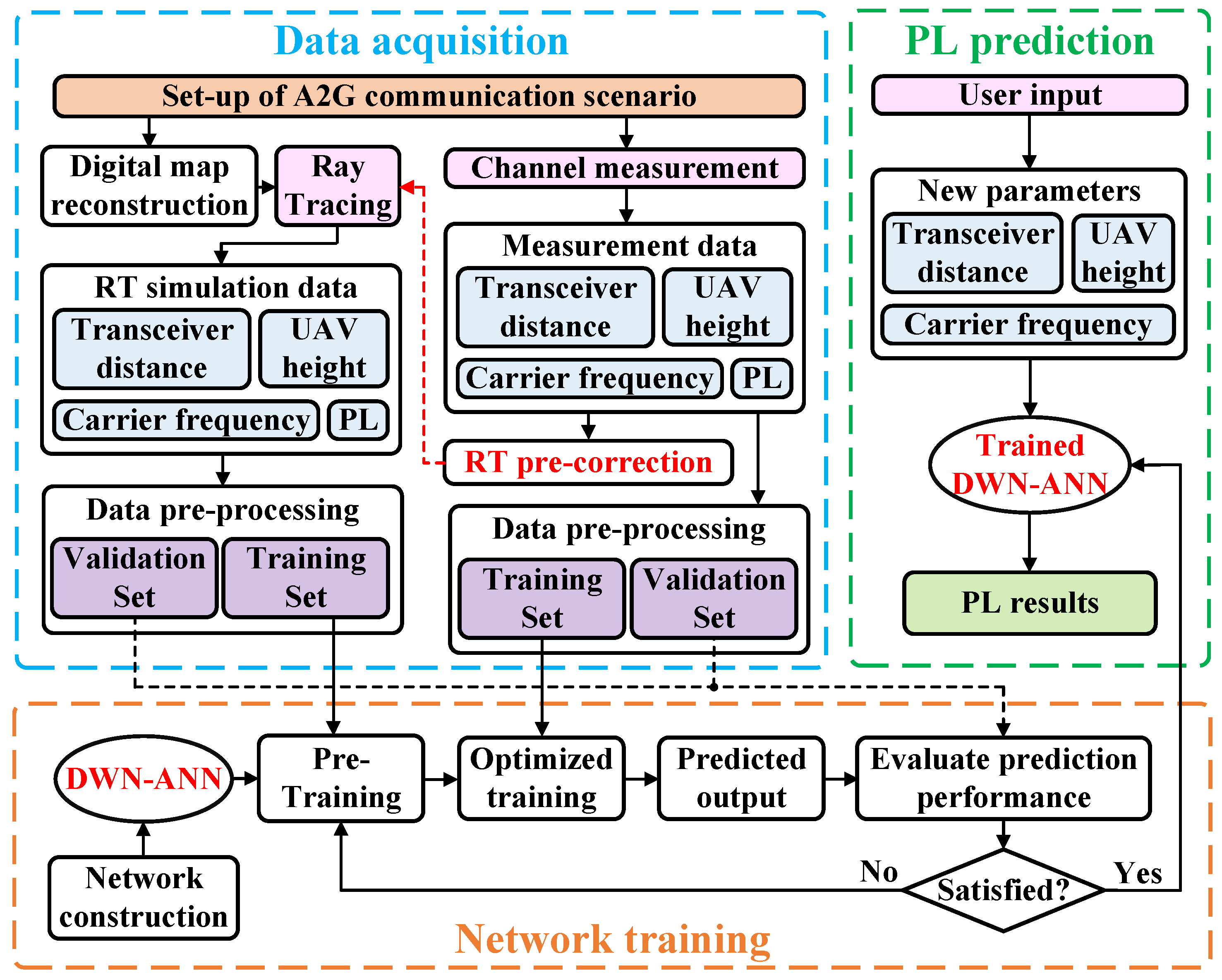


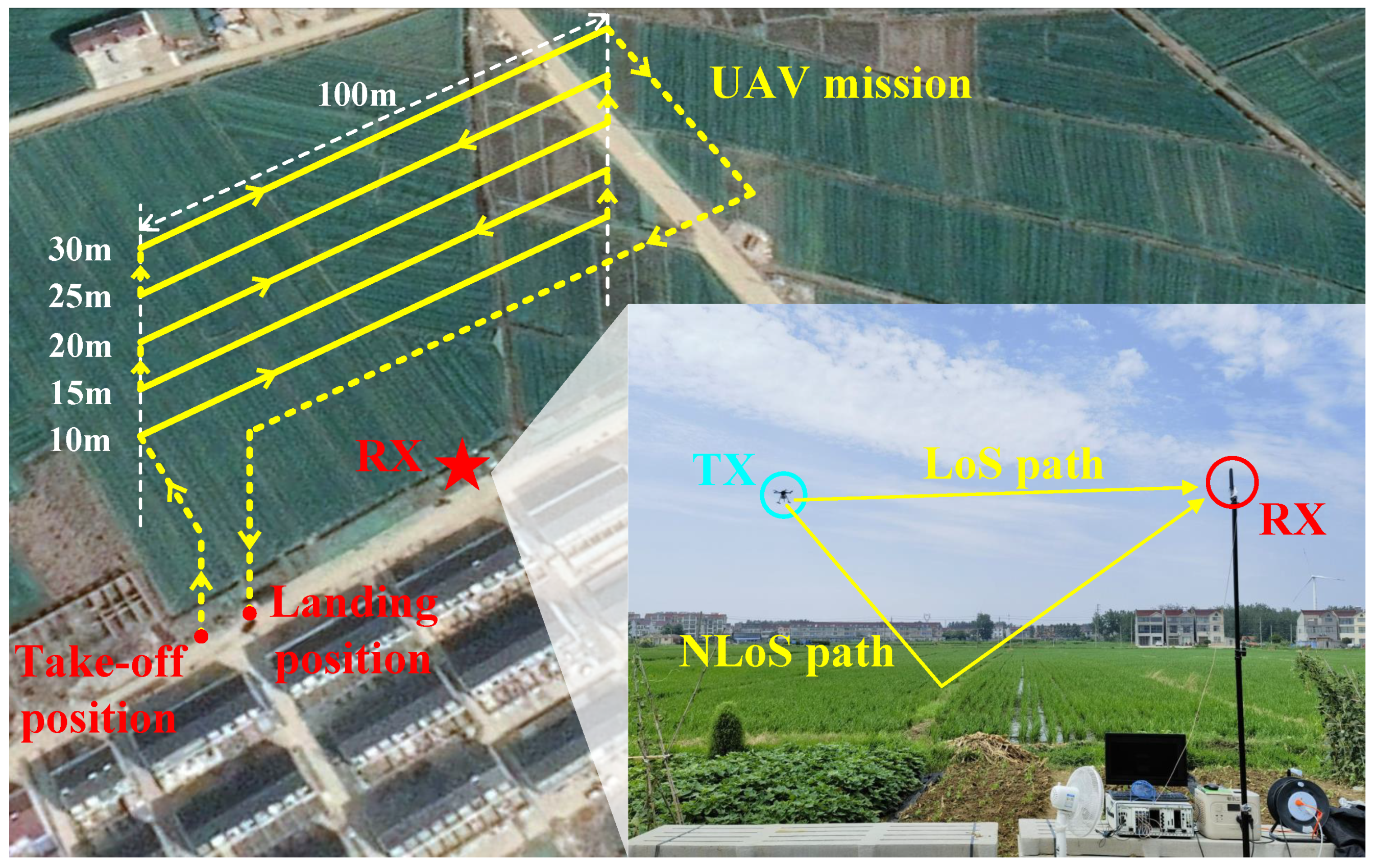
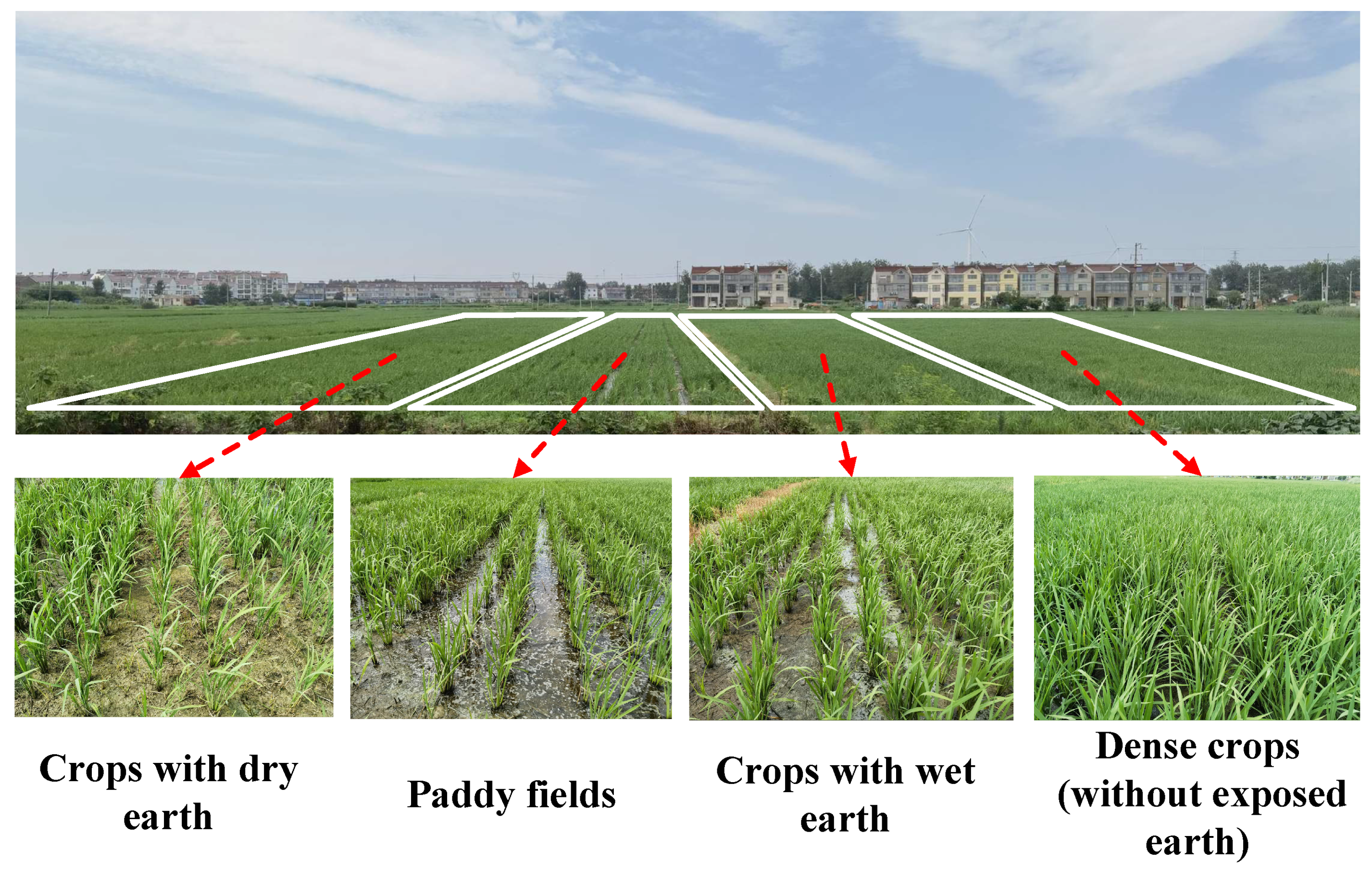
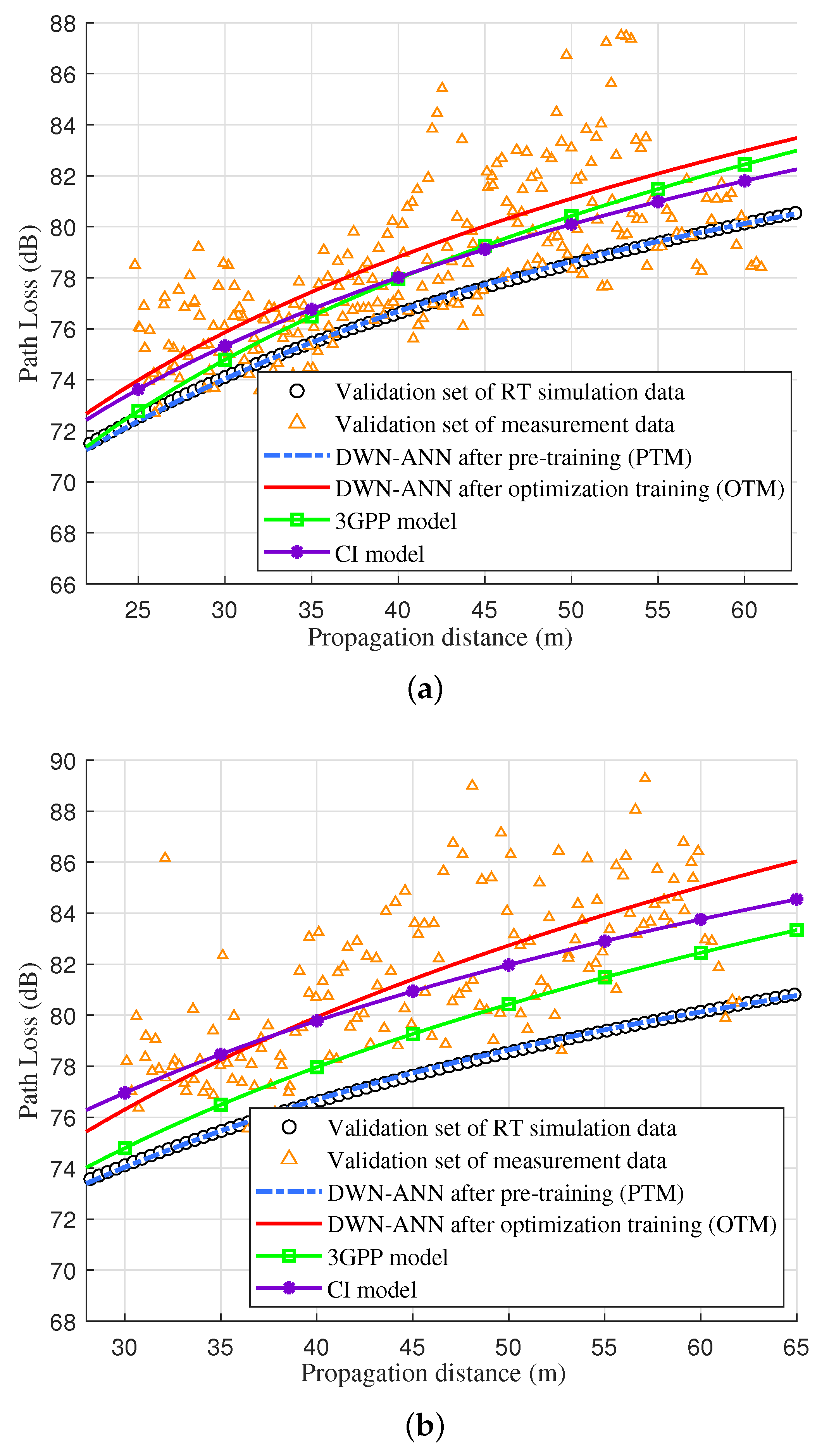
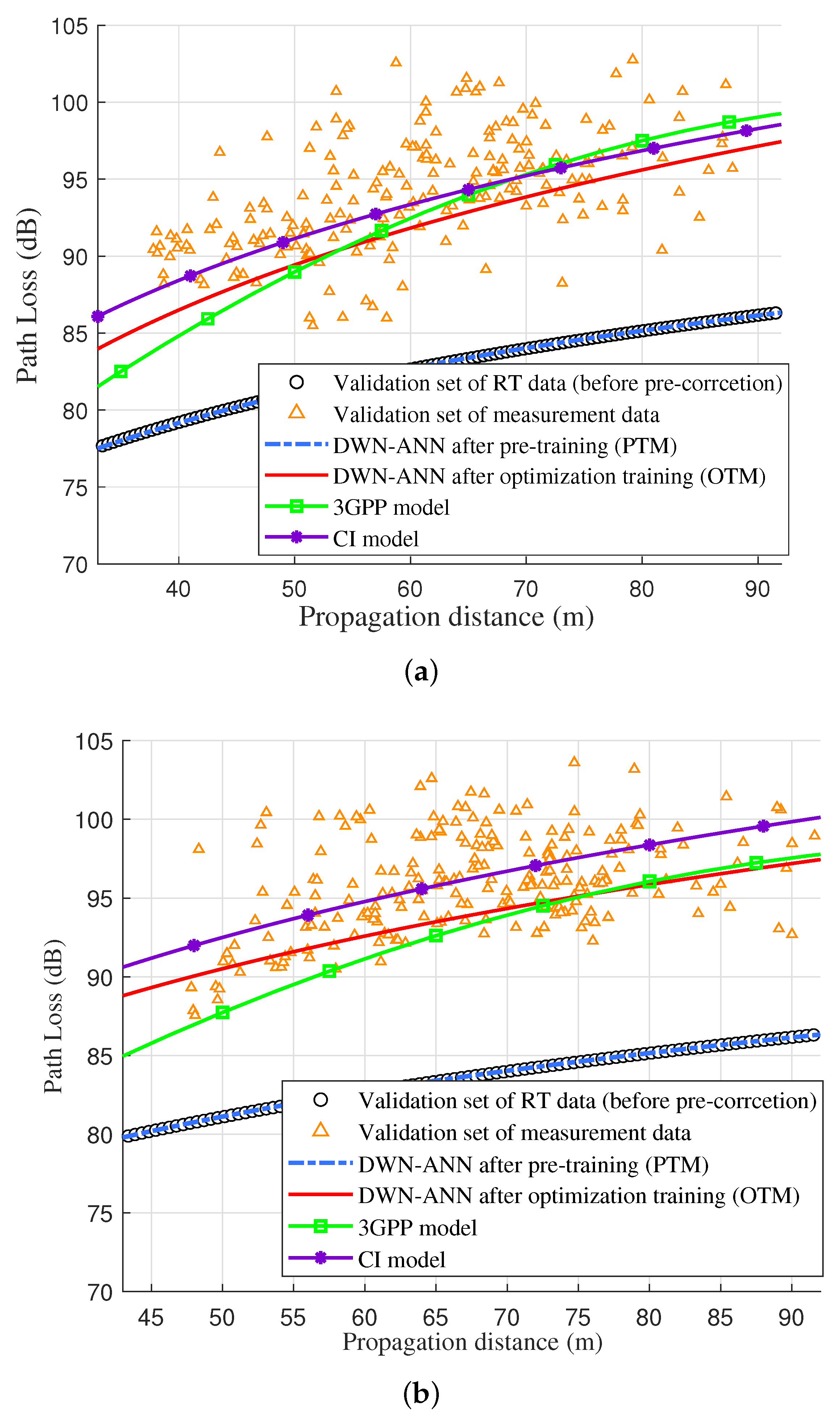
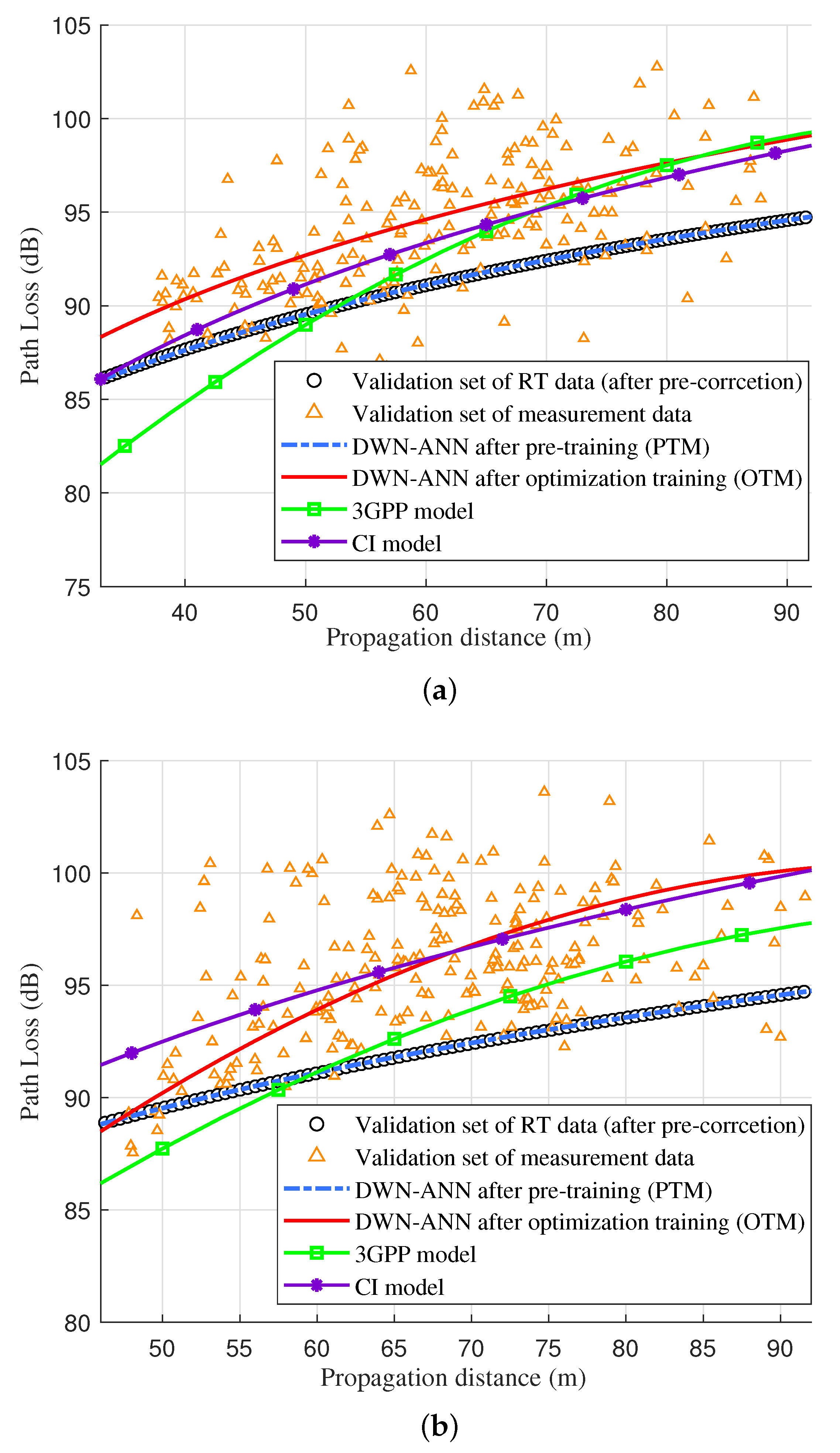
| System Parameters | Values |
|---|---|
| Supported frequency band | 100–6000 MHz |
| Bandwidth | 100 MHz |
| Transmit power | 32 dBm |
| HPA gain | 42 dB |
| Antenna type | Omnidirectional Antenna |
| Antenna gain | 2.5 dBi |
| Measurement sequence | Single-tone signal/Zadoff-Chu (ZC) sequence |
| Ground Material | Relative Dielectric Constant | Conductivity (S/m) |
|---|---|---|
| Crops with dry earth | 2.12 | 0.001 |
| Crops with wet earth | 2.2 | 0.018 |
| Paddy fields | 1.85 | 0.18 |
| Dense crops (without exposed earth) | 2.1 | 0.15 |
Disclaimer/Publisher’s Note: The statements, opinions and data contained in all publications are solely those of the individual author(s) and contributor(s) and not of MDPI and/or the editor(s). MDPI and/or the editor(s) disclaim responsibility for any injury to people or property resulting from any ideas, methods, instructions or products referred to in the content. |
© 2023 by the authors. Licensee MDPI, Basel, Switzerland. This article is an open access article distributed under the terms and conditions of the Creative Commons Attribution (CC BY) license (https://creativecommons.org/licenses/by/4.0/).
Share and Cite
Li, H.; Mao, K.; Ye, X.; Zhang, T.; Zhu, Q.; Wang, M.; Ge, Y.; Li, H.; Ali, F. Air-to-Ground Path Loss Model at 3.6 GHz under Agricultural Scenarios Based on Measurements and Artificial Neural Networks. Drones 2023, 7, 701. https://doi.org/10.3390/drones7120701
Li H, Mao K, Ye X, Zhang T, Zhu Q, Wang M, Ge Y, Li H, Ali F. Air-to-Ground Path Loss Model at 3.6 GHz under Agricultural Scenarios Based on Measurements and Artificial Neural Networks. Drones. 2023; 7(12):701. https://doi.org/10.3390/drones7120701
Chicago/Turabian StyleLi, Hanpeng, Kai Mao, Xuchao Ye, Taotao Zhang, Qiuming Zhu, Manxi Wang, Yurao Ge, Hangang Li, and Farman Ali. 2023. "Air-to-Ground Path Loss Model at 3.6 GHz under Agricultural Scenarios Based on Measurements and Artificial Neural Networks" Drones 7, no. 12: 701. https://doi.org/10.3390/drones7120701
APA StyleLi, H., Mao, K., Ye, X., Zhang, T., Zhu, Q., Wang, M., Ge, Y., Li, H., & Ali, F. (2023). Air-to-Ground Path Loss Model at 3.6 GHz under Agricultural Scenarios Based on Measurements and Artificial Neural Networks. Drones, 7(12), 701. https://doi.org/10.3390/drones7120701







